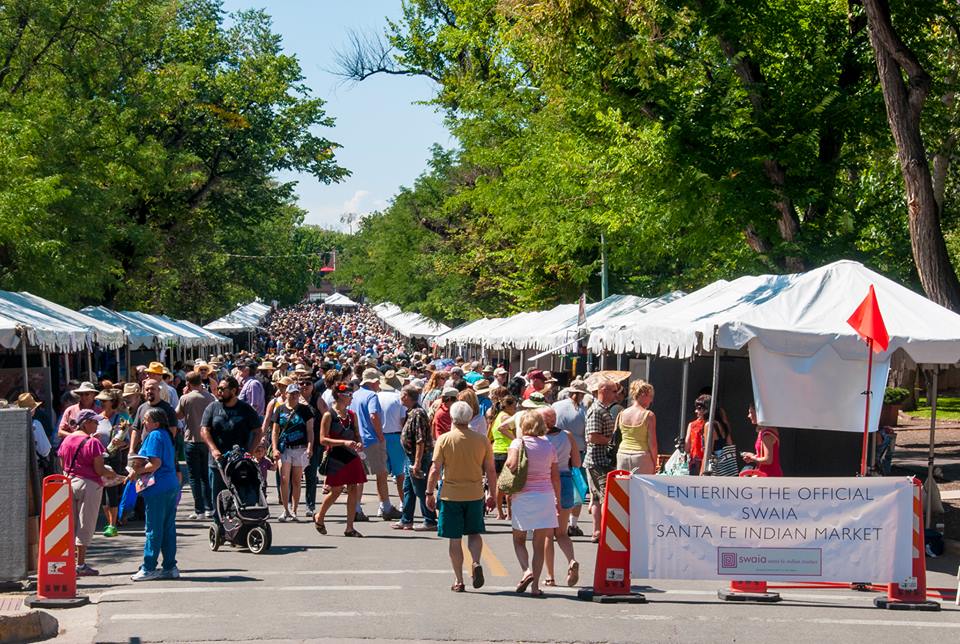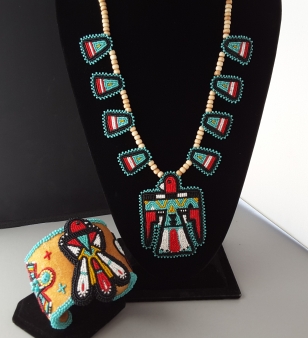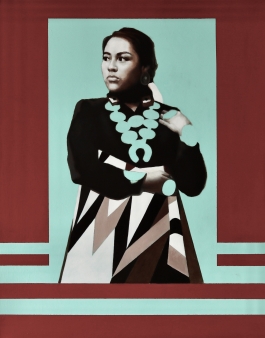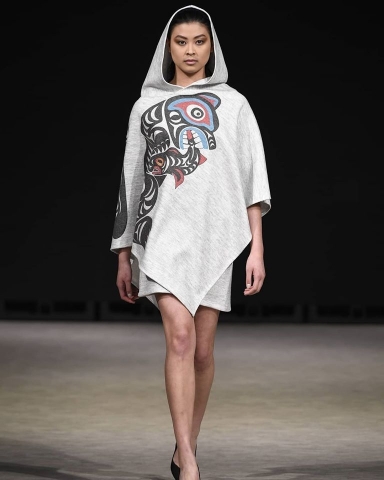
- Details
- By Tamara Ikenberg
Santa Fe, N.M. – On Saturday, Aug.1, the first Virtual Santa Fe Indian Market opens for business.
Through Aug. 31, Native Art enthusiasts can shop for jewelry, dolls, textiles, pottery, clothing, baskets and much more at the SWAIA website, from nearly 450 Indigenous artists from the United States and Canada.
In a normal year under normal circumstances, thousands of Native art enthusiasts solidly pack Santa Fe Plaza for the famous Market. But this year, the COVID-19 pandemic prompted organizers to pivot to an online-only event.
From Aug. 15 to the end of the market, customers can participate in “Virtual Booth Hopping,” where they can interact online with artists. Until then, attendees can shop the individual artists’ e-commerce sites, which they can link to via the Market’s home page. There will also be new content every day of the month, including clothing contests, panel discussions and programming from Santa Fe museums and galleries.
To whet your virtual art-shopping appetite, Native News Online selected five eye-catching, culture-packed pieces for sale in a variety of media and styles.
Return of the Thunderbird
 This beaded Thunderbird necklace and cuff by LeJeune Chavez (Santo Domingo Pueblo) will be available at the Virtual Santa Fe Indian Market, from Saturday Aug.1 through Aug. 31. (LeJeune Chavez)LeJeune Chavez’s beaded Thunderbird necklace elegantly updates her Pueblo’s storied signature piece. “The whole style of necklace is totally Santo Domingo. It’s part of our culture,” said Chavez. “I have never seen a beaded thunderbird necklace before. I always had that idea of reimagining one with beads and I finally did it during lockdown.” She loved the way the necklace turned out so much that she fashioned a matching cuff. Popular during the Depression, Thunderbird necklaces were a wearable collage of available materials. “Tribal members made necklaces like that using whatever they could find as backing to set the turquoise and the shells on,” Chavez said. “A lot of them were made with battery casings or those real thick records from the 20s.” For her updated version, Chavez set her beads on black leather. Chavez’s version pays tribute to every detail of the original necklaces. “The colors I use are the same colors used in the Depression-era thunderbird necklaces; just turquoise, red and black.” She also threw in some gold-colored beads to represent other found stones or shells that often played a part in the pieces. Just like the Thunderbird necklace makers before her, Chavez used materials she already had around the house, with one exception. “I didn’t have the bone spacer beads. That’s what they used to use. So I had to search online,” she said. “I wanted it to look as close as possible to the originals.”
This beaded Thunderbird necklace and cuff by LeJeune Chavez (Santo Domingo Pueblo) will be available at the Virtual Santa Fe Indian Market, from Saturday Aug.1 through Aug. 31. (LeJeune Chavez)LeJeune Chavez’s beaded Thunderbird necklace elegantly updates her Pueblo’s storied signature piece. “The whole style of necklace is totally Santo Domingo. It’s part of our culture,” said Chavez. “I have never seen a beaded thunderbird necklace before. I always had that idea of reimagining one with beads and I finally did it during lockdown.” She loved the way the necklace turned out so much that she fashioned a matching cuff. Popular during the Depression, Thunderbird necklaces were a wearable collage of available materials. “Tribal members made necklaces like that using whatever they could find as backing to set the turquoise and the shells on,” Chavez said. “A lot of them were made with battery casings or those real thick records from the 20s.” For her updated version, Chavez set her beads on black leather. Chavez’s version pays tribute to every detail of the original necklaces. “The colors I use are the same colors used in the Depression-era thunderbird necklaces; just turquoise, red and black.” She also threw in some gold-colored beads to represent other found stones or shells that often played a part in the pieces. Just like the Thunderbird necklace makers before her, Chavez used materials she already had around the house, with one exception. “I didn’t have the bone spacer beads. That’s what they used to use. So I had to search online,” she said. “I wanted it to look as close as possible to the originals.”
Necklace: $800
Cuff: $1,000  This multicolored stone Naja pendant by Navajo artist Tonya June Rafael will be available at the Virtual Santa Fe Indian Market, from Saturday Aug.1 through Aug. 31. (Tonya June Rafael)
This multicolored stone Naja pendant by Navajo artist Tonya June Rafael will be available at the Virtual Santa Fe Indian Market, from Saturday Aug.1 through Aug. 31. (Tonya June Rafael)
Patented pendant
Naja is the Navajo word for “crescent,” and it’s also the blanket term for the shape and style of silversmith Tonya June Rafael’s striking multicolored stone pendant. ”When you see that curve, it’s a Naja pendant. It’s been around for centuries,” said Rafael (Navajo). ”It was an adornment for horse bridles a long time ago when Spaniards came through and they brought horses to the southwest. It evolved from there and the southwest Natives incorporated it into jewelry.” Rafael, who lives in Pruitt, N.M., said Naja pendants are most commonly found on squash blossom necklaces. She suggests hanging her palm-sized pendant on a turquoise or coral-beaded chain to set off the piece’s radiant assortment of coral, turquoise, lapis and taurite stones. “I love to work with different colors of stones from all over the world,” Rafael said. She hopes her jewelry will last through generations. “I want to make things that can be an heirloom that a mom can pass to her daughter.”
Naja pendant: $1,200
The fruit of her labor
 This sweetgrass and ash wood pineapple mini basket by Penobscot weaver Ganessa Frey will be available at the Virtual Santa Fe Indian Market, from Aug. 1 to Aug. 31. (Home & Away Gallery) Producing the perfect mini pineapple basket is daunting, to put it mildly. “They’re a pain to make. Oh man, they’re a pain,” said Penobscot basket weaver Ganessa Frey, who lives in Indian Township, Maine. “The cover is a totally weird different technique that I do, and then just putting the leaves in and cutting them to the right size and the right thickness… Oh my God.“ What look like real leaves topping the pineapple started as strips of brown ash wood. Judging from the fruit of her labor, all the work was worth it. The pineapple exemplifies Frey’s fresh take on traditional Wabanaki basket weaving, the signature style of the Penobscot, Passamaquoddy, Maliseet and Mi’kmaq people of Maine. Her bright berry and pumpkin baskets will also be on sale. For the pineapple, Frey used commercial Rit Dye to get the vibrant reds, greens and yellows. She wove the basket with brown ash wood harvested by her husband Jeremy, and a bit of sweetgrass. Frey naturally knew that particular wood would serve her pineapple-making purposes. “It’s all about knowing the feel of the wood and what it’s good for. It’s kind of a muscle memory thing,” said Frey. “We run our fingers along it and we know exactly what a piece is for. It comes with experience.”
This sweetgrass and ash wood pineapple mini basket by Penobscot weaver Ganessa Frey will be available at the Virtual Santa Fe Indian Market, from Aug. 1 to Aug. 31. (Home & Away Gallery) Producing the perfect mini pineapple basket is daunting, to put it mildly. “They’re a pain to make. Oh man, they’re a pain,” said Penobscot basket weaver Ganessa Frey, who lives in Indian Township, Maine. “The cover is a totally weird different technique that I do, and then just putting the leaves in and cutting them to the right size and the right thickness… Oh my God.“ What look like real leaves topping the pineapple started as strips of brown ash wood. Judging from the fruit of her labor, all the work was worth it. The pineapple exemplifies Frey’s fresh take on traditional Wabanaki basket weaving, the signature style of the Penobscot, Passamaquoddy, Maliseet and Mi’kmaq people of Maine. Her bright berry and pumpkin baskets will also be on sale. For the pineapple, Frey used commercial Rit Dye to get the vibrant reds, greens and yellows. She wove the basket with brown ash wood harvested by her husband Jeremy, and a bit of sweetgrass. Frey naturally knew that particular wood would serve her pineapple-making purposes. “It’s all about knowing the feel of the wood and what it’s good for. It’s kind of a muscle memory thing,” said Frey. “We run our fingers along it and we know exactly what a piece is for. It comes with experience.”
Mini pineapple basket: $500
Strength and sky
 This powerful portrait of Navajo pre-med student Erin Lewis, by Choctaw artist Karen Clarkson, will be available at the Virtual Santa Fe Indian Market, from Aug.1 througH Aug. 31. (Karen Clarkson)Navajo pre-med student Erin Lewis is the turquoise-streaked subject of Karen Clarkson’s “Strength” portrait. “I decided to emphasize Erin's strength in angular forms and bold colors,” Clarkson said. The oil painting was made for the series “Today’s Native Women – Portraits of Celebration.” “It was created to showcase the resilience and achievements, as well as the hopes and dreams, of today’s contemporary Native women,” Clarkson said. “These women want you to know they will be heard, excel and accomplish their dreams, for they have learned from their elders and are grounded in tradition and love of family.” In Clarkson’s image of Lewis, which references a photo by Navajo photographer Matt Toledo, the subject merges with the sky. “Turquoise is the color of the sky and the evidence of the Creator's affection and acknowledgement,” Clarkson said. “It is an integral part of Navajo life so I made sure it was woven into her appearance. You cannot see where the turquoise jewelry ends and the sky begins.”
This powerful portrait of Navajo pre-med student Erin Lewis, by Choctaw artist Karen Clarkson, will be available at the Virtual Santa Fe Indian Market, from Aug.1 througH Aug. 31. (Karen Clarkson)Navajo pre-med student Erin Lewis is the turquoise-streaked subject of Karen Clarkson’s “Strength” portrait. “I decided to emphasize Erin's strength in angular forms and bold colors,” Clarkson said. The oil painting was made for the series “Today’s Native Women – Portraits of Celebration.” “It was created to showcase the resilience and achievements, as well as the hopes and dreams, of today’s contemporary Native women,” Clarkson said. “These women want you to know they will be heard, excel and accomplish their dreams, for they have learned from their elders and are grounded in tradition and love of family.” In Clarkson’s image of Lewis, which references a photo by Navajo photographer Matt Toledo, the subject merges with the sky. “Turquoise is the color of the sky and the evidence of the Creator's affection and acknowledgement,” Clarkson said. “It is an integral part of Navajo life so I made sure it was woven into her appearance. You cannot see where the turquoise jewelry ends and the sky begins.”
Painting: $3,000
Grizzly wear
 This wool hoodie depicting a grizzly bear eating a salmon was created by British Columbia brand Ay Lelum – The Good House of Design, run by sisters Sophia and Aunalee Good (Snuneymuxw First Nation). It will be available at the Virtual Santa Fe Indian Market, from Aug.1 through Aug. 31. (Ay Lelum)A chic, hooded cape from Ay Lelum – The Good House of Design, captures a scene of a grizzly bear devouring a salmon. “It’s part of our K’wuyucyn (Grizzly Bear) collection, inspired by our family song and our father's story of the grizzly bear,” said Aunalee Boyd-Good. “The story tells of the first grizzly bear ever.” To hear the K’wuyucyn song behind the collection, visit the Ay Lelum Spotify page, which also features more Coast Salish traditional music and images of Ay Lelum apparel. The brand, based in British Columbia, is a second-generation Coast Salish design house, and all members of the Good family (Snuneymuxw First Nation) play a role in fashioning wearable art. Sisters Aunalee Boyd-Good and Sophia Seward-Good design the clothing, and were mentored by their mother Sandra Moorhouse-Good. Their father William and brother Joel create the artwork adorning the dresses, t-shirts, face masks and more. Joel brought the grizzly bear story to life for the cape. “It is amazing to work in a multigenerational family environment where we learn from our parents and pass it on,” Aunalee said. “In following the traditions of our ancestors as taught by our father, working together unites us and allows us to do this essential work to keep our culture alive.” The wool/polyester cape comes in two sizes, s/m and l/xl, which covers plus sizes.
This wool hoodie depicting a grizzly bear eating a salmon was created by British Columbia brand Ay Lelum – The Good House of Design, run by sisters Sophia and Aunalee Good (Snuneymuxw First Nation). It will be available at the Virtual Santa Fe Indian Market, from Aug.1 through Aug. 31. (Ay Lelum)A chic, hooded cape from Ay Lelum – The Good House of Design, captures a scene of a grizzly bear devouring a salmon. “It’s part of our K’wuyucyn (Grizzly Bear) collection, inspired by our family song and our father's story of the grizzly bear,” said Aunalee Boyd-Good. “The story tells of the first grizzly bear ever.” To hear the K’wuyucyn song behind the collection, visit the Ay Lelum Spotify page, which also features more Coast Salish traditional music and images of Ay Lelum apparel. The brand, based in British Columbia, is a second-generation Coast Salish design house, and all members of the Good family (Snuneymuxw First Nation) play a role in fashioning wearable art. Sisters Aunalee Boyd-Good and Sophia Seward-Good design the clothing, and were mentored by their mother Sandra Moorhouse-Good. Their father William and brother Joel create the artwork adorning the dresses, t-shirts, face masks and more. Joel brought the grizzly bear story to life for the cape. “It is amazing to work in a multigenerational family environment where we learn from our parents and pass it on,” Aunalee said. “In following the traditions of our ancestors as taught by our father, working together unites us and allows us to do this essential work to keep our culture alive.” The wool/polyester cape comes in two sizes, s/m and l/xl, which covers plus sizes.
Cape: $295
More Stories Like This
First Tribally Owned Gallery in Tulsa Debuts ‘Mvskokvlke: Road of Strength’Zuni Youth Enrichment Project and Partners at Ho’n A:wan Productions Launch 8th Annual Delapna:we Project
Chickasaw Holiday Art Market Returns to Sulphur on Dec. 6
Center for Native Futures Hosts Third Mound Summit on Contemporary Native Arts
Filmmakers Defend ‘You’re No Indian’ After Demand to Halt Screenings
Help us defend tribal sovereignty.
At Native News Online, our mission is rooted in telling the stories that strengthen sovereignty and uplift Indigenous voices — not just at year’s end, but every single day.
Because of your generosity last year, we were able to keep our reporters on the ground in tribal communities, at national gatherings and in the halls of Congress — covering the issues that matter most to Indian Country: sovereignty, culture, education, health and economic opportunity.
That support sustained us through a tough year in 2025. Now, as we look to the year ahead, we need your help right now to ensure warrior journalism remains strong — reporting that defends tribal sovereignty, amplifies Native truth, and holds power accountable.
 The stakes couldn't be higher. Your support keeps Native voices heard, Native stories told and Native sovereignty defended.
The stakes couldn't be higher. Your support keeps Native voices heard, Native stories told and Native sovereignty defended.
Stand with Warrior Journalism today.
Levi Rickert (Potawatomi), Editor & Publisher

